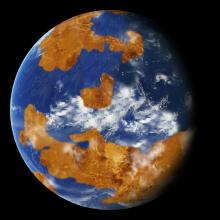Listen to today's episode of StarDate on the web the same day it airs in high-quality streaming audio without any extra ads or announcements. Choose a $8 one-month pass, or listen every day for a year for just $30.
You are here
Moon and Venus
Venus is a world you probably wouldn’t want to visit. When the solar system was young, though, it could have been the most hospitable of all the planets — a world with oceans and a comfortable atmosphere.
Today, Venus’s atmosphere is made mainly of carbon dioxide, with surface pressure more than 90 times greater than on Earth. And the surface temperature is more than 850 degrees Fahrenheit.
But a study released last year found that conditions on Venus could have been relatively comfortable for a long time.
Researchers looked at Venus’s atmosphere, its landscape, and its rotation on its axis. And they used models of climate behavior and other factors.
When they ran the numbers, they found that shallow oceans could have covered much of the surface for up to two billion years. And air temperatures could have remained comfortable through most of that period.
Eventually, though, all that came to an end. As the Sun aged, it got brighter, which bombarded Venus with more energy. The oceans evaporated, and water molecules were split apart by solar radiation. The water’s hydrogen escaped into space, while the oxygen combined with carbon to make carbon dioxide. That created a runaway greenhouse effect — transforming Venus from paradise to purgatory.
Even so, Venus is still beautiful to look at. It’s the brilliant “morning star.” Tomorrow, it’s close to the lower left of the Moon at dawn — a beautiful world that might have had a beautiful past.
Script by Damond Benningfield





